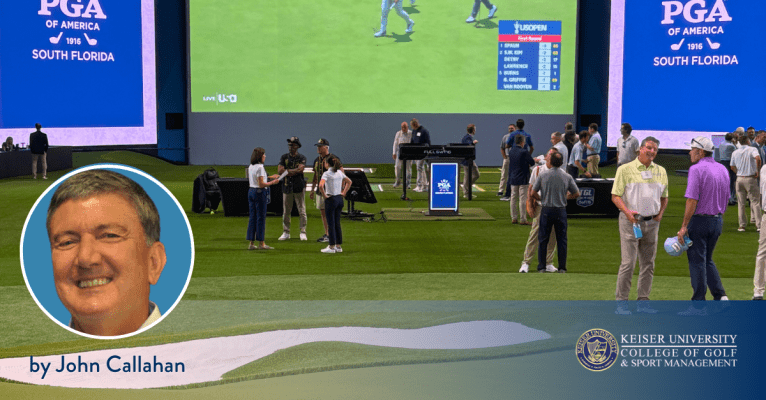What is Tomorrow’s Golf League (TGL)?

By John Callahan, Keiser University College of Golf Professor and PGA Professional
TGL, also referred to as “Tomorrow’s Golf League,” is a novel, technology-infused golf league founded by Tiger Woods, Rory McIlroy, and Mike McCarley (via their venture TMRW Sports), in partnership with the PGA Tour. It aims to blend traditional golf skills with indoor simulators, short game arenas, and compelling broadcasting formats, producing a new kind of spectator experience designed for primetime. The first official matches began on January 7, 2025.
As a golf purist, my first reaction was that TGL would dilute the essence of competitive golf I have loved throughout my adult life. Besides the fact that competitive golf is meant to be played outside with all the varying factors, competition should be long enough to identify a true champion. TGL matches are short (details below) and designed to fit into a two-hour TV timeslot. I often ask my students at Keiser University, College of Golf, this question: “If you had to play Tiger Woods for your life, and were allowed to choose how many holes the competition would be, how many holes would you choose?” After they think about it, most students come up with the logical answer: one hole. Any golfer could get lucky enough to beat Tiger for one hole. However, the longer the competition, the more your chances drop precipitously. PGA Tour events are 72 holes over four days—long enough to determine the best player in the week.
Vision and Goals
TGL’s founding philosophy is to reimagine how golf is consumed, shifting away from long, sprawling stroke-play tournaments to fast-paced, viewer-friendly, team-based matches that fit into two-hour evening time slots.
Some of its key goals include:
- Attracting new, younger audiences who might find traditional golf broadcasts slow or less engaging.
- Bridging live action and simulation: creating a hybrid experience that connects real shot input with virtual outcomes, then finishing holes in a live, terrain-morphed green.
- Primetime television slot: Unlike many golf broadcasts during the daytime, TGL aims to occupy evening time slots where a larger general audience can tune in.
- Technological spectacle: using cameras, shot clocks, mic’d-up players, and dynamic course changes to increase drama and engagement.
- Complement, not replace: TGL is structured to run in harmony with the PGA Tour schedule, not supplant it.
In short, TGL is as much a media/entertainment platform as it is a sports organization. It’s a gamble that technology + format innovation can expand golf’s reach and relevance.
Venue: The SoFi Center & Technical Infrastructure
A central piece of TGL’s differentiator is its custom-built venue called the SoFi Center, located in Palm Beach Gardens, Florida (on the campus of Palm Beach State College).
- The playing surface is approximately 97 yards by 50 yards, roughly the size of a football field (slightly smaller).
- It is divided into two distinct zones:
- Screen Zone: where players hit shots (drives, fairway shots) into a giant projection screen. The screen is approximately 53 feet high by 64 feet wide and positioned between 20 and 35 yards from the shot locations.
- Green Zone: once a ball lands within approximately 50 yards of the target “pin” on the screen, the match transitions to live play on a physical, morphing green and adjacent bunker areas.
- The green/bunker complex is mounted on a 41-yard turntable that can rotate, change orientation, and adjust slope/topography using approximately 600 motorized actuators. This allows the same physical space to represent many hole designs, with angles, breaks, and contours that change dynamically.
- Surrounding the green, real sand bunkers are incorporated for short-game shots.
- Shot boxes (for the tee/fairway side) are not synthetic mats: instead, they offer three real-surface types—cropped grass (for tee/fairway), tall grass (rough), or sand (bunker), depending on where the shot is simulated to land.
- Overhead LED spotlights highlight exactly where the ball lies on the turntable, and the rotation helps simulate the angle and approach orientation.
- The interior is designed to accommodate up to ~1,500 spectators, featuring closed-in seating allowing fans to watch both the screen and the green zones in near real-time.
Format, Rules, and Gameplay
One of the more compelling parts of TGL is how it combines creative formats with traditional match concepts. Here’s a breakdown of how matches are structured, how scoring works, and how the technology features interact.
Each TGL match is divided into two sessions, making a 15-hole contest:
- Triples (Holes 1–9): This is a 3-vs-3 alternate-shot format (one team of three players vs. another), utilizing alternate-shot rules. That means the three players on a team take turns hitting shots—in effect, Team A uses player order 1 → 2 → 3 → 1 → … etc., depending on hole design. Before each match, teams decide the hitting order.
- Singles (Holes 10–15): This is head-to-head match play, where each of the three players on one team plays two holes against one player from the opposing team. The mapping is:
- Player 1 vs Player 1 on Holes 10 & 13
- Player 2 vs Player 2 on Holes 11 & 14
- Player 3 vs Player 3 on Holes 12 & 15
- Each hole is worth one point, and traditional match-play rules apply (fewer strokes wins, ties are worth zero points).
If the match is tied at the end of 15 holes, there is a sudden-death tiebreaker: players will compete shot-for-shot (closest to the pin) until one team wins a hole.
While the physical space is fixed, TGL utilizes 30 virtual holes that have been pre-designed and developed in partnership with design firms (Beau Welling Design, Nicklaus Design, and Pizá Golf) and a technology partner (Full Swing Golf). Each virtual hole has a nickname and a par value (3, 4, or 5). The league’s competition committee predetermines the sequence of holes used in a match.
Teams, Players, and Ownership
Initially, TGL launched with six teams, each featuring four PGA Tour pros.
Here are the founding six (2025 season) teams and their owners/notable affiliations:
| Team | Players (examples) | Ownership / Notes |
|---|---|---|
| Atlanta Drive GC | Patrick Cantlay, Lucas Glover, Billy Horschel, Justin Thomas | Owned by Arthur Blank (owner of Atlanta Falcons) |
| Boston Common Golf | Keegan Bradley, Rory McIlroy, Hideki Matsuyama, Adam Scott | Owned by Fenway Sports Group (Boston Red Sox, Liverpool FC) |
| Jupiter Links | Max Homa, Tom Kim, Kevin Kisner, Tiger Woods | Owned by TGR Ventures (Woods’ entity) + David Blitzer |
| Los Angeles GC | Tommy Fleetwood, Collin Morikawa, Justin Rose, Sahith Theegala | Owned by Alexis Ohanian, Serena Williams, and other limited partners |
| New York GC | Matt Fitzpatrick, Rickie Fowler, Xander Schauffele, Cameron Young | Owned by New York Mets owner Steve Cohen |
| The Bay Golf Club | Ludvig Åberg, Wyndham Clark, Min Woo Lee, Shane Lowry | Owned by Marc Lasry’s Avenue Sports Fund + Stephen Curry |
Opening Night and Viewer Ratings
TGL’s debut on January 7, 2025, drew about 919,000 viewers during the 9–11 p.m. ET slot on ESPN—an impressive number for a new golf format. That viewership exceeded recent numbers for LIV Golf broadcasts and even the PGA Tour’s earliest events for that week. Because viewership skewed younger than typical golf audiences, it signals potential in TGL’s goal of reaching underserved or under-engaged demographics. Despite critics, many in golf view TGL as a bold experiment that could lead to a new mainstream format or remain a niche entertainment product.
2025 Season & Results (First Season)
Some salient highlights from TGL’s inaugural season:
- The regular season ran from January to early March, with each team playing 15 matches.
- The playoffs culminated in a SoFi Cup final series in late March.
- Atlanta Drive GC emerged as champions, defeating New York GC in the final.
- The prize money for the champions was substantial: $9 million for the winning team (i.e., each player received $2.25 million).
- New York GC earned $4.5 million (i.e. $1.125 million per player) for their runner-up finish.
- Other payout details: Jupiter Links (Tiger’s team) finished 5th and earned $1.75 million ($437,500 per player). Boston Common (McIlroy’s team) finished last, collecting $1.5 million ($375,000 per player).
- Many matches sparked vibrant fan discussion on social media/forums, showing that a segment of the golf community is actively tracking and debating TGL play.
The first season showed that TGL can deliver suspense, player drama, and TV-worthy moments.
Critical Reflections and Evaluation
It’s valuable to take a step back and assess TGL not just on its novelty, but also its long-term viability, value to the golf industry, and associated risks. In the sports world, numerous attempts have been made to modernize or reform existing sports (e.g., Twenty20 cricket, The Hundred, rugby sevens, 3×3 basketball). Some succeed; others remain niche. TGL is part of that broader push: can tradition integrate with spectacle?
In golf, prior attempts at alternative formats (such as short courses, team events, and skins) have had a variable impact. TGL’s unique edge is in its tech + media infrastructure. Its success will hinge on whether it can maintain that edge and scale.
Summary and Takeaways
TGL (Tomorrow’s Golf League) is a bold experiment that combines elite golf talent with indoor simulation, strategic formats, and a highly produced broadcast presentation. It seeks to bring golf into the primetime era, appealing to new audiences while preserving elements of traditional play. Its first season (2025) produced champions, strong viewership, and excitement. However, the long-term success of TGL will depend on whether it can sustain novelty, scale, control costs, ensure technical reliability, and maintain player and fan commitment.
If TGL can navigate those challenges, it has the potential to permanently expand how golf is consumed. If not, it may remain a fascinating but short-lived side venture. In either case, its current existence is a sign that the world of golf is exploring new boundaries.














